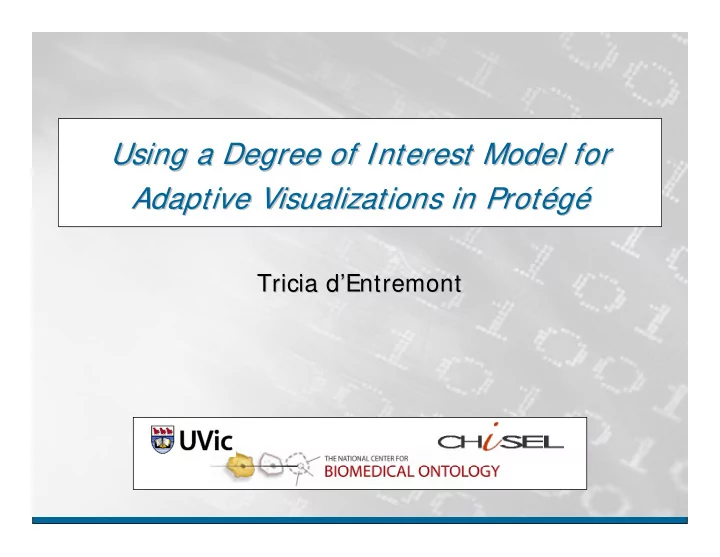

Using a Degree of Interest Model for Using a Degree of Interest Model for Adaptive Visualizations in Proté ég gé é Adaptive Visualizations in Prot Tricia d d’ ’Entremont Entremont Tricia
Motivation Motivation Motivation • Understanding the structure of and navigating DI aMOND within large ontologies is cognitively demanding Adaptive-Viz Protégé • Navigating the ontology is difficult Jambalaya – Long scrolling lists, expanding/collapsing nodes – Large number of irrelevant elements occlude Features relevant information Future Work Conclusion • Visualizations of structure often very dense and complex – Hard to know which elements to display July 25, 2006 July 25, 2006 the CHI SEL group, University of Victoria the CHI SEL group, University of Victoria 2 2
DIaMOND (Project) (Project) DIaMOND Overview • DIaMOND—Degree of Interest Modeling for DI aMOND Ontology Navigation and Development (http://www.thechiselgroup.org/diamond) Adaptive-Viz Protégé Jambalaya • Applies principles of attention-reactive interfaces (Card at PARC) Features – Mechanism to calculate user’s degree of interest (DOI) Future Work – Dynamic display of information using the DOI Conclusion • Goals – Draw user’s attention to interesting elements – Reduce navigation overhead July 25, 2006 the CHI SEL group, University of Victoria 3
DIaMOND (Plug (Plug- -in) in) DIaMOND Overview • Uses the Mylar degree of interest model plug-in for DI aMOND Eclipse (Kersten at UBC) • Associates a degree of interest (DOI) value with Adaptive-Viz Protégé elements in the ontology – Classes Jambalaya – Slots Features – Instances Future Work • Uses the DOI value to provide adaptive visualizations of the ontology Conclusion – highlight and filter elements within Protégé’s views and Jambalaya’s graph-based visualizations July 25, 2006 the CHI SEL group, University of Victoria 4
DIaMOND (plug (plug- -in) in) DIaMOND Overview • Three levels of interest DI aMOND – Landmark: Hub concept Adaptive-Viz • Manually specified by user Protégé • DOI value exceeds a threshold value Jambalaya – Interesting • Has been interacted with such that the DOI value Features exceeds a (lower) threshold value Future Work – Uninteresting • DOI value falls below the lower threshold value Conclusion • DOI calculation decay function • Lightweight, easily reversible focus techniques • Consistent with existing, familiar Protégé views. July 25, 2006 the CHI SEL group, University of Victoria 5
Highlighting and Filtering in the Class Browser Highlighting and Filtering in the Class Browser Overview DI aMOND Adaptive-Viz Protégé Jambalaya Features Future Work Conclusion Standard Highlighting Highlighting & Filtering July 25, 2006 the CHI SEL group, University of Victoria 6
Jambalaya Jambalaya Overview • What is Jambalaya? DI aMOND – Protégé tab plug-in built on top of SHriMP Adaptive-Viz – What is SHriMP? Protégé • Multiple, interchangeable, interactive graph views Jambalaya • Provides multiple perspectives at different levels of abstraction Features • Smooth animated zooming & layout transition Future Work • Embedded, editable Protégé forms Conclusion • Originally for software comprehension • Also a plug-in for Eclipse (Creole) July 25, 2006 the CHI SEL group, University of Victoria 7
Adaptive Visualizations— —Jambalaya Jambalaya Adaptive Visualizations Overview • Currently: DI aMOND – Same three interest levels Adaptive-Viz • Landmark, interesting, un-interesting Protégé – Font highlighting, bolding on node labels Jambalaya – Transparency used to “highlight” actual nodes Features • In progress: Future Work – Motion techniques to capture user’s attention Conclusion – Node size to show DOI value – Intelligent node label display July 25, 2006 the CHI SEL group, University of Victoria 8
July 25, 2006 the CHI SEL group, University of Victoria 9
July 25, 2006 the CHI SEL group, University of Victoria 10
July 25, 2006 the CHI SEL group, University of Victoria 11
DIaMOND plug plug- -in features in features DIaMOND Overview • Integrated with Classes, Slots, Forms, Instances, DI aMOND and Instance Tree Tabs • Integrated with Owl Classes, Properties, Individual Adaptive-Viz Protégé and Forms Tabs Jambalaya • Synchronized across tabs (almost) • Threshold values are user configurable Features • Highlighting of uninteresting, interesting and Future Work landmark concepts is user configurable – Font colour Conclusion – Font weight – Font style (italics?) July 25, 2006 the CHI SEL group, University of Victoria 12
Future Work Future Work Overview • Evaluation DI aMOND – Beginning initial evaluation – Interested in feedback from the community Adaptive-Viz Protégé – Shameless plea for participants ☺ Jambalaya • Sharing DOI among users Features Future Work • Role-based modeling Conclusion • Task-based DOI calculations • Use of instance data to supplement DOI calculations July 25, 2006 the CHI SEL group, University of Victoria 13
Conclusion Conclusion Overview • Acknowledgements DI aMOND – Mik Kersten Adaptive-Viz – Chris Callendar Protégé – National Center for Biomedical Ontology Jambalaya Features Future Work Conclusion July 25, 2006 the CHI SEL group, University of Victoria 14
References References Overview • Card, S. Degree of Interest Trees: a Component of an Attention-Reactive User Interface. Advanced Visual DI aMOND Interfaces. May 22-24, 2002. Adaptive-Viz Protégé • http://www.eclipse.org/mylar Jambalaya • http://www.eclipse.org Features Future Work • Kersten, M. and Murphy, G. C. 2005. Mylar: a Degree-of- Interest Model for IDEs. In Proceedings of the 4th Conclusion International Conference on Aspect-Oriented Software Development. March 14-8, 2005. July 25, 2006 the CHI SEL group, University of Victoria 15
Thank You. Thank You. Computer Human Interaction & Software Engineering Lab Department of Computer Science, University of Victoria July 25, 2006 the CHI SEL group, University of Victoria 16
Recommend
More recommend